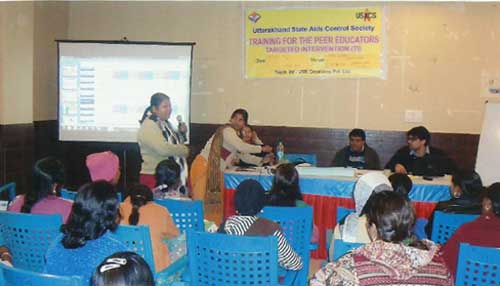|
|
The overall goal of the fourth Phase of the NACP
(2012-2017) is to reduce new infections by 50% (2007 Baseline of NACP III) and
Comprehensive care, support and treatment to all persons living with HIV/AIDS.
NACP IV has adopted an approach to consolidate the gains made in high prevalent
states and intensify the response in low prevalent but highly vulnerable state.
The most cost-effective means of reducing HIV spread is through the
implementation of Targeted Intervention (TIs) amongst persons most vulnerable to
HIV/AIDS, such as sex workers, men who have sex with men, and injecting drug
users known as core groups and truck drivers, migrants known as bridge
population or bridge group. Both NACO and the State AIDS Control Societies place
a high priority upon full coverage of the state with TIs and other prevention
activities such as expanding access to STI services
It is estimated that more than 90% of HIV transmission in India is related to
unprotected sexual intercourse or sharing of injecting equipment between an
infected and an uninfected individual. Given this pattern of epidemic
transmission, it is most effective and efficient to target prevention to the HRG
members to keep their HIV prevalence as low as possible, and to reduce
transmission from them to the bridge population.
• HIV prevalence in the general population is 0.27%, FSWs 1.56%, IDUs 6.26%, MSM 2.69% .
• To gain control over HIV/AIDS spread in the country TI
• To prevent new infections in High Risk Groups and General Population.
• To ensure quality health services to HRG
• To strengthen referrals.
• To strengthen community participation in the program operations and management.

Targeted intervention is peer-led and there is NGO-supported outreach and behaviour change communication which
is through differentiated outreach/communication based on risk and typology. Focus is also on interpersonal behaviour change communication (IPC).
• Condom Promotion
Every person should have access to condoms when he/she needs it. Through its Primary Strategy provision is for free supply of condoms to HRGs through TI NGOs/CBOs and in the secondary Strategy stress is on promoting social marketing of condoms through Social Marketing Organizations.
• Community Mobilization
Building community’s ownership of the TI objectives through collectivisation, emphasis is on collective decision-making and creation of a space for the community events. Building capacity of community groups to assume ownership of the programme through formation of various committees like DIC Management Committee and Clinic Committee.
• Referrals & Linkages
Linkages to STI and health services with strong referral and follow-up
Promotion/distribution of commodities including free condoms, lubricants,
needles/syringes Linkages to other health services (e.g. for TB) and integrated
counseling and testing centers (ICTCs). Provision of safe spaces (DICs).
• Management of STIs
STI services: an opportunity for prevention education to the individual as well
as to his/her partner. Planning for STI services is done with the HRGs.
Availability of services is ensured as per the needs of the community (for e.g.
late-night access).It is emphasized that there is Accessibility of services at
optimal locations (i.e. not too far from the major sex work sites) and
Clinicians have an attitude of respect towards the community.
• Enabling environment
Through this component stress is on creating a crisis response/management system
and conducting advocacy with key stakeholders/power structures response system
and promoting legal rights education.
Uttarakhand State AIDS control Society is implementing the targeted
intervention program through 24 NGOs in the state in 08 districts. There
are 06 Targeted Intervention program are being implemented for FSW, 03 TI
program for Injecting Drug Users, 06 core composite for FSW,MSM-TG and IDUs. While for migrant population there are 06 bridge group interventions
while 3 Intervention programs are being implemented among Truckers for
Prevention of HIV/ AIDS.
The targets allocated to the partner NGOs are
based on the mapping study done by the Raman Development consultants (RDC). The
estimation given by the RDC for FSW was 4247 and against this estimation the
coverage by our TI partners is 3750. Similarly MSM were estimated to be 1340 and
the coverage is 1275 and for IDU the estimation is 1650 and coverage is 3427.
Under the bridge group intervention 65000 migrants and 40000 truckers are being
covered.
TI Staff Positions of the TI NGOs is as per the NACO HR policy guidelines, TIs ngo have the following staff members:
• Project Manager/Coordinator
• Counselor/ANM
• Accountant cum M&E
• Outreach Worker
• Doctor (part-time)/ Preferred Provider
There are Peer Educators/Peer Leaders who are integral part of peer education
program and recruited from community on honorary basis to link the community
members with HIV/AIDS prevention and care services.
Together with support from the SACS and the technical support unit the partner
NGOs are implementing the program in the state.
Opioid Substitution Therapy (OST) Center:
There are five OST centers in the State situated in Haldwani, Rudrapur, Dehradun
, Kashipur
and Haridwar. These OST centers are established in the Government Health
Facilities. The Injecting Drug Users (IDUs) are provided with OST medicines on
daily basis based on DOT strategy. The purpose of provisioning the oral
medicines is to switch the Injecting mode of drug intake of the IDUs and prevent
transmission of HIV infection which they often share. Through OST the drugs are
provided on prescription of a trained Doctor. Thus the IDUs take medicines and
lead a quality life and contribute economically to the family income.
Strategic Expertise Technical Unit (SETU)
Uttarakhand has a Technical Support Unit P.H.F.I. to provide technical support to the SACS and the NGOs. The program officers
in the TSU regularly visit the NGOs and provide required support and handholding
to the NGOs. There is strong team of program officers and team leader
including a medical officer to look after STI Management.
List of TI NGOs
List of OST Staff
List of OST Centers
Evaluation Reports of TI NGOs Financial year 2021-22
|
Copyright © Uttarakhand State AIDS Control Society.
All Rights Reserved. Designed and Managed By @ Trade In Services |

|